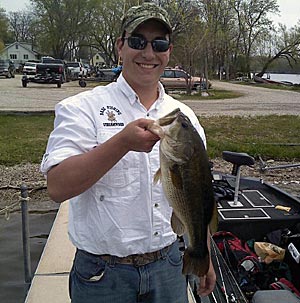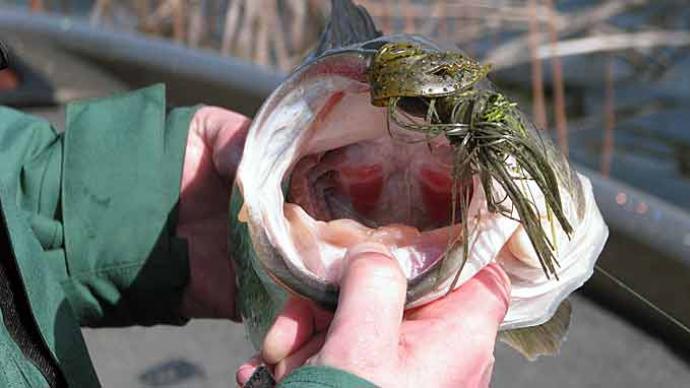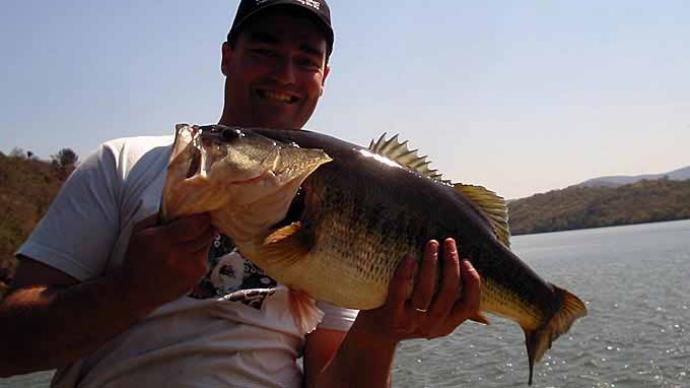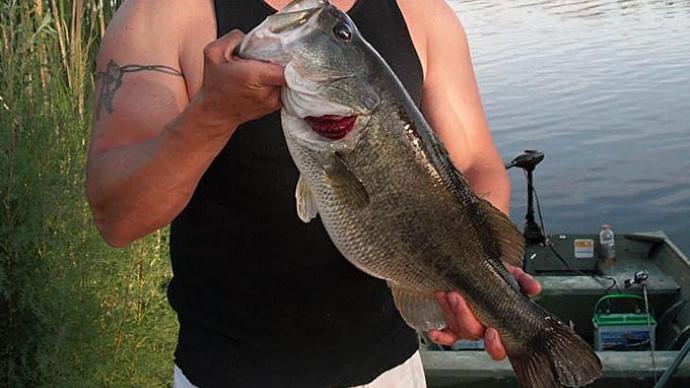
For starters, I am a firm believer in using braided line. I usually stick to 50- pound Power-Pro, and if I am fishing in clear water, I will put 20-pound P-Line Fluorocarbon leader that is about 20 inches long. My rod selection is a 7' 2" Shimano Zodias medium-heavy rod. My reel is a Lew's BB1 Speed Spool baitcaster with a 6.2:1 gear ratio. Many folks prefer a faster ratio, such as a 7.1:1 or a 7.4:1. They believe that if you hook a bass in weeds or under a dock, you need something to rip it out of there. I agree with them, but I am more comfortable using a 6.2:1 ratio. Try not to stray below a 6.2:1 ratio. It may be too slow. My Shimano rod is a Medium Heavy power with a Fast Action tip. Some prefer Heavy power rods for jigging, but to me, it's a bit overkill, especially if you use a lighter jig such as 1/4-ounce.
A heavy power rod will be ideal if you fish somewhere with a lot of submerged weeds, structure, or Lilly pads. However, that is why I use braid; I can rip my bait out of there, and the line won’t get torn up like plastic lines. Also, I use a leader in clear water because if I have my jig tied to braid and the water depth clarity is over five to seven feet, then it just looks like a crawfish being pulled by a piece of rope. The fluorocarbon leader gives me that edge, so the bass don’t see my line. I have experienced this firsthand. A couple of years back, fishing in a tournament for my high school, we were fishing the pre-spawn in some clear water, and I was using a jig with braided line and saw this bass just sitting right outside a weed line about four feet down. I danced my jig as best I could, but nothing worked. Finally, my fishing coach suggested I tie on a fluorocarbon leader, which I did, I pitched my jig back out there, and the bass hit instantly.
Now to my jig selection. I have a lot of different kinds of jigs. However, I have about three to four jig companies that I always have as my go-to jigs. The first company I use is Booyah. I use three different jigs by them; the Boo Jig, Swim n Jig, and Bankroll Jig. One reason why I choose Booyah is that I love the presentation that their jigs provide for me. They stand up easier, and their skirts don’t fold down as some do. Instead, their skirts stay up and fan out and provide the perfect amount of bulk and profile; I have them in black and blue, white shad, black and red, and green pumpkin.
I also like to use the Bitsy Bug by Strike King. If the bite is slow and light, I usually like to tie this on and throw it out there. I have one Bitsy Bug in watermelon and the other in bleeding black and blue.
The third company I use strictly for bulk. They are the Buckeye Mop and Mini Mop Jigs. These jigs, in particular, have tremendous bulk and are perfect in stained water. I only have one color, black and blue, because that is all I use in stained water.
Another Jig I use is the Jewel Baits EF Finesse Flip'n Jig. This Jig is a finesse Jig, and I love throwing this out there during the spawning season. Now I only have one color for this jig: green pumpkin green flash. Some throw on a trailer the same color as the jig, but I stray a little for this color and use a Sweet Beaver by Reaction Innovation called California 420. Again, you must have the dark side of the Sweet Beaver facing up.
I have other companies I use, but these are the ones that give me the most success when pulling those huge lunkers out.
In addition to your jig selection, your trailer selection is just as important, if not more important. I have only three brands that I use when it comes to trailer selection. My go-to trailer before any other is the Sweet Beaver by Reaction Innovation. They have an excellent swirl pattern when fished on a Texas or Drop-shot rig and have outstanding two-tone colors. Not only are they tough little suckers and compact, but they can survive multiple hits by bass. They have outward-facing ribs that create pressure waves that attract bass like no other. When the water first thaws out, keep the tails together but as the pre-spawn starts, split the tails apart, just like you would on the appendages on a lizard or brush hog.
The second brand is Uncle Josh. They make trailers out of actual pork, which gives an excellent feel, taste, and presentation for bass. I use both Jumbo Pork and The Original Pork Frog as my trailers. Some say that they are hard to take off your jig. You must take them off and put them back in their container because they will dry out. Uncle Josh provides a little pre-made hole to put your hook through, so you don’t have to punch it. In that one side of the body is fleshy and the other is a beveled texture, you want to put the hook through the beveled texture and angle it a little bit when you take it off. You may have to wiggle it around to get it off. The more you use it, the easier it will slide off.
The third brand is Net bait. I love using their Paca Craw. The Paca Craw features a small body with two claw "appendages" that are just massive. They add an excellent profile to any jig you fish them with. The claws flap when moved and create a ton of vibration and pressure waves. I especially love using them with swim jigs. I've had bass come up from the shadows of weed lines and hammer my swim jigs because of the trailer I was using.
Now, because you have all this fancy stuff, all you have to do is cast out your jig and trailer combination, and you'll get a bass. Not exactly. I have four techniques I use when fishing jigs. Two techniques are obvious just by their names.
The Swim Jig
Just cast it out, and depending on the depth, let it sink a little and swim it back. Now don’t just throw it into open water and expect it to get bit. A swim jig is basically a spinnerbait without the blades. You MUST fish it the same as a spinnerbait. Throw it back behind a fallen tree and swim it back. Throw it over weeds, next to a weed line, next to cover, on a shelf, under structure, next to structure; and if you hit a stump, let it fall as you would spinnerbait. (Cover- Lilly pads, cattails, matted grass, any forage that is right on top of the water)
(Structure- any stump, dock, rock, pillar, fallen tree, log, etc.) The other is obvious as well.
The Hopping Jig
I call it hopping, mainly because it is easier to memorize. Just hop the jig back to you. I usually alternate sequences by hopping it three times, letting it set for ten to fifteen seconds, then hopping it twice, and so on. It's pretty easy.
Another technique I like to use is to find out what is on the bottom of the water I'm fishing so I can get a feel of the area below me - and it'll get you fish too. It's as simple as jigging. Cast your jig out, let it sink to the bottom, and drag it. There is no need to reel, bounce, jig, swim, or anything; drag it. All you got to do is twist at the waist away from where you cast, turn back, reel up the slack, and repeat. I use this technique a lot from when the water first thaws until it freezes again. It helps me feel for transition points and if there is grass, sand, muck, etc. This also imitates a crawfish scavenging the bottom for food.
The last technique is tricky, but you can get the hang of it. I call it whacking a jig. I use this mainly during the pre-spawn, through the spawn, and post-spawn. I do this to get a reaction bite out of the fish. Sometimes I'm fishing a bed, and the bass stares at my jig, but they will not bite. That’s when I take my jig and whack it off the bottom. It cannot be too soft to where it will not have any effect or too strong to where you pull it out of the water. It has to be just the right amount. Since bass don’t have hands, they must react with their mouths. I've gotten a lot of fish by them staring at my jig and then just whacking it off the bottom.
BassResource may receive a portion of revenues if you make a purchase using a link above.




